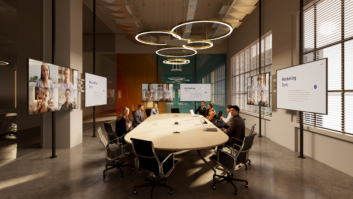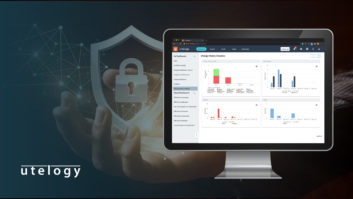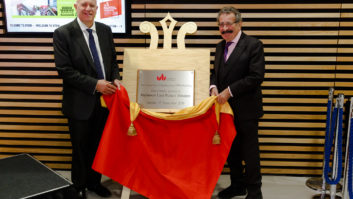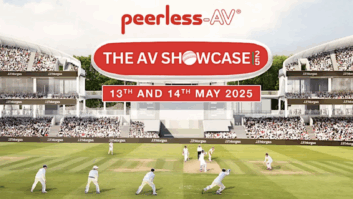A look at how AV technology is improving the match day experience for sports fans, both inside and outside the venue
There is nothing quite like the excitement of going to a game. From climbing onto trains and buses full of fans wearing your team’s colours, to spilling out into a nearby pub for an optimistic pint or two before the walk through the normally quiet streets to your beloved stadium. The anticipation and tension of the journey to your seat in the stadium is exhilarating, and it is all part of the experience.
In the world of AV, that experience is being enhanced to make the fan feel even more part of their team, and to bring the brands that support that team to life.
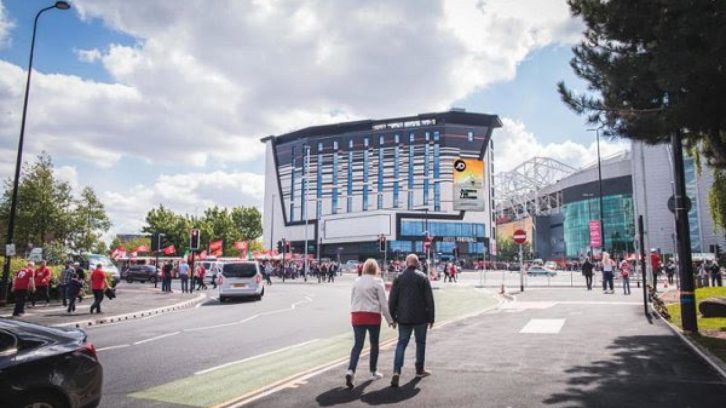
Approaching the stadium
Walking towards the stadium, the fan can see the home of their beloved team. This is where lighting and audio can begin to raise the bar. On how stadiums are using technology to enhance the fan’s first impressions of an event, club or brand, infiLED EM’s co-founder and managing director, Ben Da Costa, notes that with a rapidly evolving offering, stadiums are utilising new and exciting technology to deliver an all-encompassing experience to fans.
“Stadiums around the world have become fully ‘connected’ in the last decade, with a shift in fan engagement that allows marketers to be much more creative when it comes to activations or branding exercises,” Da Costa says. “As they say, first impressions count, and for a club or brand, it’s vital to capture the target audience at a match or game even on the approach to the venue. Simple and effective, large scale displays and screens have always been a valuable method of providing eye-catching content to the masses. Sports teams and sponsors alike continue to expend these valuable assets to increase brand exposure, advertisement of coming events, and club sponsors to thousands, and even millions of fans.”
Stadiums are using AV technology to enhance the fan’s first impressions of events, clubs and brands. Says Daniel Gray, marketing officer at adi.tv: “Increasingly, I think we’re starting to see a shift in the way clubs and stadiums think about how they use their venues to create an impression. Clubs and venues have really started to think about what it means to deliver excellent fan experience, long before supporters enter the stadium, and display technology, in particular, plays a big part in bringing that to life.
“We see this with the proliferation of external displays and fan zones, with the latter really designed to give fans the opportunity to come together before the game. Display technology is an enabler that can help clubs create compelling experience zones,” Gray adds.
On the approach to stadiums, Iain Gregory, director for solutions and marketing, large venue, at Harman Professional Solutions, says the integration of audio, video, lighting and control systems is allowing each technology to play a supporting role in the creation of a powerful and emotive fan experience. “The first impression often occurs when the fan approaches the venue, long before the game starts. Architectural lighting can be used to accent architectural features, wash surfaces with colour or project graphics.
“With a simple preset recall, the look of the venue can be customised to suit particular teams, holidays, organisations or countries,” Gregory goes on. “Projection can also be used to display logos, shapes or patterns on large surfaces. LED dots, strips and grids can be arranged on the exterior of a building and used as pixels in a giant canvas, where event-specific video content can be run on a media façade. Exterior loudspeakers can be used to augment video content, play music or provide promotional information.”
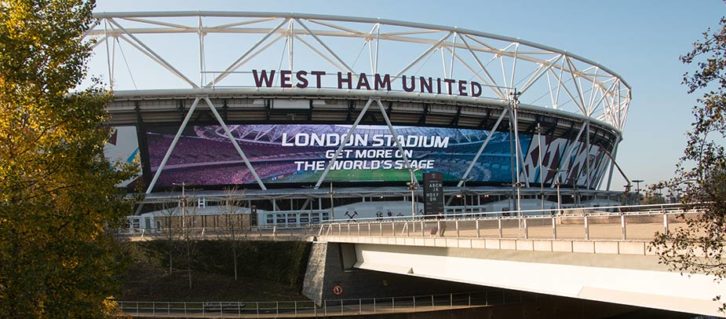
At Queen Elizabeth Park in London (above), Daktronics installed a 1,128 square metre curved LED display above the entrance to the facility. It is one of the largest LED displays in Europe and it is tilted slightly towards the ground for better viewing as fans approach the venue. Meanwhile, the US Bank Stadium in Minneapolis, Minnesota, went in a different direction with a curved sail display from Daktronics in front of the building on the Legacy Ship feature. This is a direct connection to the Minnesota Vikings, the venue’s main tenant. It is a feature that fans interact with by posing for pictures before and after events and also brings immediate branding to the event.
Adi.tv provides a whole range of display solutions for the NFL in London, which are all designed to add value to the fan experience. From the street party that takes over central London days before game day, to the tailgate parties outside the stadium, adi.tv screens provide a platform to help entertain the crowds and provide a platform for brand activation.
Comments Gray: “This is a huge area of focus for us, really because our customers are expressing demand. We provide permanent and temporary LED screens for fan zones in many sports, from Premier League and EFL clubs to Rugby Union and the recent European Championships. And when the NFL comes to London, they really show the UK how it’s done!”
However, Gray adds that stadium owners need to think more about what they are putting on screens on the approach to a stadium. He explains: “Increasingly, we’re providing display solutions to enhance event experiences for fans before they enter the stadium. But those screens are pretty useless without compelling content. That’s where I think we bring a lot of value because, as well as being able to offer a huge array of display solutions, we have a whole production department whose job it is to create great content.
“Taking Premier League team Everton as an example, we provide five or six content channels for the club, which are all delivered by our team of producers, directors and graphics operators remotely from our facility in Preston,” Gray continues. As fans arrive at the Everton stadium, Goodison Park, hours before kick off, Adi’s Fan Zone LED screens provide a focal point for the pre-match entertainment. The company mixes the screen output, taking local camera feeds into its remote gallery and pre-produced content that the team has filmed and edited earlier in the week.
Gray goes on: “Display technology is certainly going to become increasingly prevalent in and around sports venues. But with more displays, more consideration needs to be given to the way in which that content is produced and delivered. Venues must think about the value their platforms offer fans and they need to get creative about the way they activate brand partnerships. Why go to the effort of installing new display technology only to stick a brand logo on it?”
As to challenges associated with making the approach to a stadium interesting, Gregory states that location is key. “There is a trend to move sports facilities to downtown locations where guests can benefit from other infrastructure and transport options, but in a downtown location, the stadium may be competing on visual appeal with other architecture or illuminated structures.
“Traffic noise may also impact audio quality and speech intelligibility from exterior loudspeakers. Any loudspeakers placed outside must be rated for outdoor usage so that exposure to the elements doesn’t result in degradation of appearance or audio,” Gregory points out.
Adds Brent Stevens, professional sports sales manager at Daktronics: “Part of the challenge is working with the existing or planned architecture of the building and its façade. The displays should be designed to fit within that architecture and to compliment the building rather than stick out like an afterthought that was added last minute.”
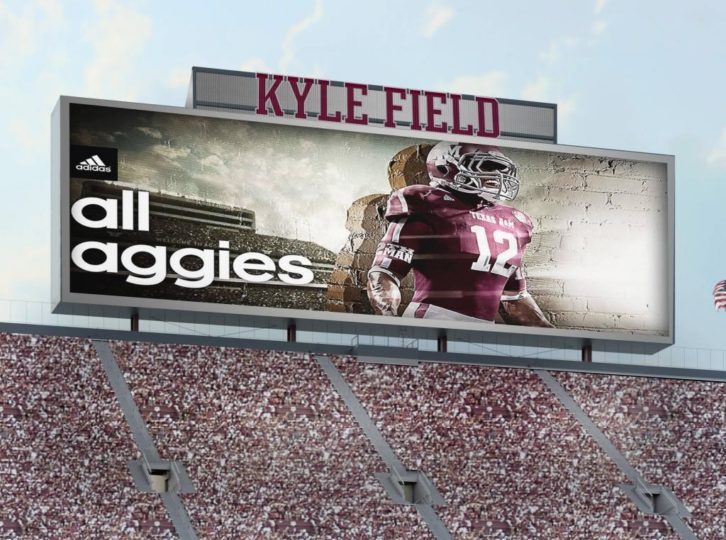
Going forward, Stevens says dynamic way-finding is an area that might see expansion for the display industry in the future. “An example we’ve seen is Texas A&M University in College Station, Texas. Outside their stadium, they installed LED street furniture displays to help fans with way-finding and direct them to their seats, team stores and concession stands. They also provide the opportunity to share upcoming event information, branding and sponsorship messages throughout the week and during non-game days.
“More and more entertainment districts are popping up around sports facilities. Bars, restaurants and retail are increasing the time the fans spend on site. Instead of showing up as the game starts, fans are now showing up well in advance and increasing the time they are engaging with the event or area,” he continues.
Entering the concourse
Now inside the stadium, lighting and audio can be used to drench the fan in the sights and sounds of their team, as well as to really begin to bring branding to life. Through infiLED EM Australian partners VuePix, infiLED provided a fully customised digital sign in the shape of huge ‘AO’ for the 2017 Australian Open. This eye-catching feature on the concourse area of the venue was a multi-purpose screen, loaded with colourful designs and patterns, promoted the times and locations of matches, and also helped push the social media hashtags for the event.
Adi.tv’s sister company, Eleven Sports Media, offers a StatZone concourse solution, which dynamically turns raw match data into compelling visual displays that help tell the story of the game. The network of displays, installed throughout the Premier League and EFL, offers a new branding platform for local and national brands to reach fans in the stadium.
Meanwhile, Stevens comments: “At Mercedes-Benz Stadium in Atlanta, Georgia, we’ve installed narrow pixel pitch displays in club spaces to help brand the events and give fans connection to the games while away from their seats. There is also the Feather Wall four millimetre display in the entryway to engage fans as they enter the stadium and transition from outside the venue to the internal experience.
“At SAP Center, the San Jose Sharks are using their narrow pixel pitch displays in the concourses to connect with fans while away from their seats and engage with them throughout the venue,” continues Stevens. “They also have the flexibility to cater to each event held at the facility and sharing branding and sponsor messages in those areas surrounding the event itself. It’s become an all-encompassing approach to brand an entire event for SAP Center and their corporate partners.”
On challenges of the concourse, Stevens says extra caution is taken to ensure content can be seen at close distances. “This is where we suggest employing narrow pixel pitch LED technology with pixel spacing of less than three millimetres. This technology provides more detailed and crisp imagery without the bevels common to stacked LCD screens to create a video wall. It adds an element of luxury and high quality to the space. We also have to take into consideration code regulations and making sure that our displays fall within these codes. Keeping the cabinets narrow and flush up against the wall is important to prevent display damage as well as patrons safe.”
Gregory says that one of the biggest challenges of the concourse area is the number of AV sources, number of AV destinations and the sheer physical size of the areas. Displays, column speakers and pendant speakers can be placed throughout the concourse to provide desired coverage but signals must still be brought to them.
Gregory states: “Several years ago, both manufacturers of AV hardware began to leverage standard IT networking hardware to transport content from source to destination. Contemporary AV traffic can now be placed on facility IT networks and managed in the same way as other network traffic. This means that networked AV devices can be distributed throughout the facility and scaled by simply adding more devices to the network.”
Connectivity is opening up opportunities within the concourse. Gregory says the potential of a networked approach is a fully converged network with closer integration of sub-systems. “However, in reality, sub-systems are still typically separated (either physically or logically,) to segment systems by type, simplify troubleshooting, and mitigate risk. A more integrated system may facilitate closer interaction between sub-systems but could also vastly increase complexity.”
As to the potential of the concourse, Da Costa notes that, “the match day experience is constantly evolving, and the concourse is where clubs and their sponsors have almost free reign to capture the minds – and wallets – of their audience, both pre and post-match”.
He adds: “We’ve seen customers specify curved style screens that can be used on the front of kiosks across the concourse to catch the public’s attention and push sales.
“In the ‘connected stadium’, there’s also ample opportunity to create engaging and memorable experiences for fans, including the installation of interactive screens using gesture input, like a photobooth, an app or video game experience, and even LED interactive dance floors.”
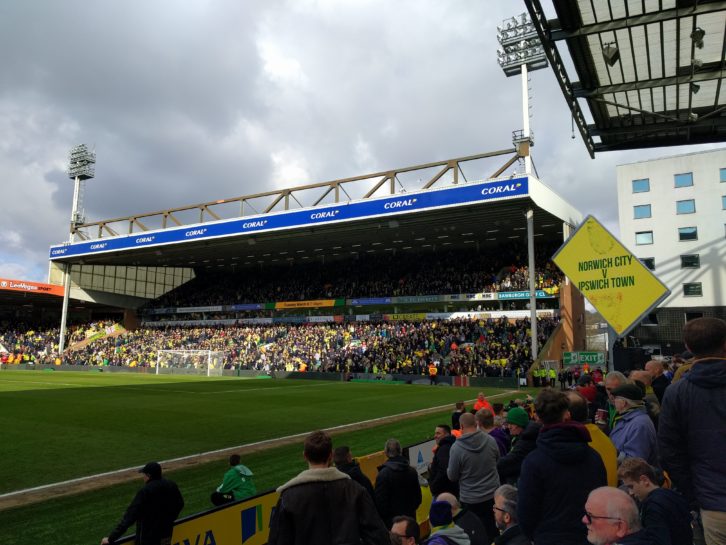
Stadium magic…
Finally, the fan enters the stadium. The smell of freshly cut grass, mixed with fried onions, stale beer, Deep Heat (for those by the dugout) and Lynx Africa. Nerves jangling with anticipation for the match. As the fan looks around the stadium, what is the AV doing to increase their engagement, hook them further into key brands, and make them want to come back for more?
Cutting edge tech is most at play within the stadium itself. Stevens says everyone seems to be looking for something unique for their fans, specific to their brand or fitting to their venue and architecture. “The more they can show their audiences and connect with them, the better their venue will be perceived and the more likely fans are to return again and again. Due to viewing distances, size and reliability is more important than tighter pixel pitches. The real cutting edge technology is in the control room and engagement technologies such as High Dynamic Range (HDR) imaging.”
David Patton, vice president for product and commercial at Supponor, states that LED perimeter systems have become known for providing access to powerful inventory that can be sold to brand partners, sponsors and advertisers to promote their products and services to key target audiences, meaning that they have offered little value in terms of fan engagement. He explains: “Perimeter advertising began as local and in-stadium activation using static billboards, targeting local businesses and service providers to local people present at the event. However, with increased demand for live broadcast sports, growing viewing figures and the advent of animated LED perimeter signage, the exposure for TV visible signage that is almost in the action alongside the field of play, has made it a platform for higher impact global brand reach – while local in-stadia experiences lost out.
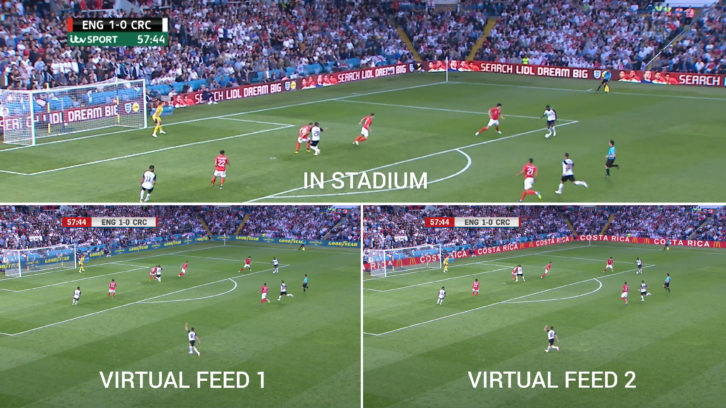
“Virtual replacement technologies have been gaining momentum and technological sophistication over the past decade, and now provide rights holders with the best of both worlds,” he goes on. “Its primary function is to replace physical content displayed on in-stadium LED perimeter boards authentically and unnoticeably replaced in the digital domain for television broadcast signals; the advanced software and hardware technologies behind these solutions open opportunities for rights owners to access increased digital sponsorship and advertising inventory, allowing for incremental revenue growth by enabling brand partners to deliver ever more relevant and targeted messages to TV audiences.”
However, an indirect and valuable by-product of this technology is that it has the potential to liberate the physical in-stadium perimeter LED displays to be used as part of more focussed fan engagement activities and improved in-stadium experiences, Patton notes. “Clubs can now reward those fans that have made the effort to be there, with live social media feeds, statistics from the game or the league, specific local offers or information from sponsors or local advertisers; the possibilities are almost limitless. “
Many European football leagues and US sports federations including the NFL and NHL are already deploying this technology, adds Patton; in Germany’s Bundesliga, it is used for all of Borussia Dortmund’s home games and many of its away games, and Spain’s La Liga deploys the technology for the away games of football giants Real Madrid, Barcelona and Atletico Madrid. The FA and ITV have begun to use it for England internationals, while many Premier League and Championship clubs are investing in virtual-enabled systems ready for future exploitation.
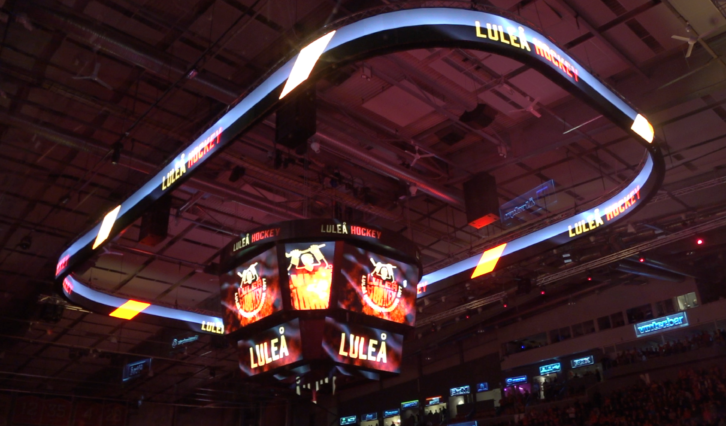
Stadia signage is infiLED Sports speciality, and its award-winning installation at Lulea Ice Hockey Arena in Sweden was a prime example of this. It was an entirely custom built display with a bespoke curved frame with a chamfered edge. Now, the all-in-one curved screen circling the perimeter of the arena hangs brightly above the ice providing scores, time-keeping, and advertising for the club and for its sponsors.
Gray comments that adi.tv is working with a number of UK clubs, including Wolves and Southampton in the Premier League, to integrate its display technology into pre-match light shows to increase the atmosphere. “The synchronisation of music to stadium lights, LED screens, digital ribbon, and perimeter displays creates a really rousing experience, especially when adding pyrotechnics in the mix. Again, it starts with content. We’ll work with clubs to film, edit and produce high impact content that integrates with every digital display.”
Gray adds: “As in-venue connectivity gets better, which it will over time, it opens up many more opportunities to engage with fans in the venue, not just pushing content to their connected devices but also allowing fans to push content to the screens much more.”
On the audio side, Gregory states that while high-quality audio and even coverage is important, “speech intelligibility is vital to guest experience and revenue generation”. He notes that if a guest cannot hear a promotional announcement clearly, it could result in a lost sale. “If a guest can’t hear a safety announcement clearly, that could have a far more serious impact,” he continues. “For audio systems which augment life safety systems, achieving specified STI (Speech Transmission Index) levels is essential.”
As to what the future could hold for in-stadium AV, Da Costa concludes: “In-stadia signage will need to meet the demands of the modern connected stadium, and the fans. In the future, we could see more interactivity between audience and technology, which is why all of infiLED Sports screens are capable of being interactive, including app control, environmental sensors and physical sensors, such as pressure or light sensors, providing endless application possibilities, limited only by the imagination of the design.”
Let’s hope our fan’s team wins the match!

